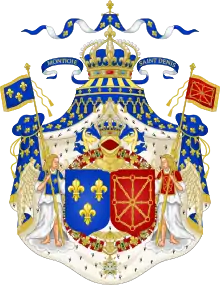Montjoie Saint Denis!
Montjoie Saint Denis! (French pronunciation: [mɔ̃tʒwa sɛ̃ d(ə).nis]) was the battle-cry and motto of the Kingdom of France. It allegedly referred to Charlemagne's legendary banner the Oriflamme, which was also known as the "Montjoie" (Old French: Munjoie; "cairn")[1] and was kept at the Abbey of Saint Denis, though alternative explanations exist (see below). The battle-cry was first used during the reign of Louis VI of France, the first royal bearer of the Oriflamme.[2]

Etymology of "Montjoie"
The etymology of the term "Montjoie" is uncertain. It is first recorded in The Song of Roland (12th century). The Catholic Encyclopedia suggested it originated in a term for marking stones or cairns set up on the roadside, in Late Latin known as mons Jovis, which from c. 1200 in French appears as monjoie.[3] According to the Encyclopedia, cairns were used by warriors as gathering places and the term was applied to the Oriflamme by the analogy that it was a place warriors gathered for combat.[4] "Montjoie" has also been proposed as being derived from a Germanic source, mund gawi ("pile of stones"), supposedly used as a battle cry in a sense of "hold the line!". It has alternatively been proposed as deriving from mund galga, from mund "protect" and galga "cross, rood" (as pilgrims would often affix crucifixes to these stones).[5][6] Charles Arnould claimed the word originated in Gaulish mant- "path" and gauda "pile of stones". [7]
Etymologies also exist that do not connect the term "montjoie" to the traditional explanation of the Oriflamme. Henri Diament believed it was in reference of the martyrdom of Saint Denis, which he claimed was associated with a Mons Jovis or Mons Gaudii. However this connection is unexplained, as the name of the place of St Denis' martyrdom, Montmartre, originated from Mons Martis rather than Mons Jovis. A connection to Montmartre is re-affirmed by G. Bugler, who believed the "joie" came from "Gau", or region, presumably translating the phrase as "the place of the hill of St Denis". Laura Hibbard Loomis believed the phrase to have originated from "meum gaudium" (my joy). An alternative Latin etymology was given by Gerhard Rohlfs, who connected it to "Mons Gaudii", a name given by medieval pilgrims to a point where one would get their first glimpse of their destination.[8]
References
- "Montjoie", accessed 2017-11-19, http://www.larousse.fr/dictionnaires/francais/montjoie/52518
- Goyau, G. (1911). Oriflamme. In The Catholic Encyclopedia. New York: Robert Appleton Company. Retrieved January 2, 2018 from New Advent: http://www.newadvent.org/cathen/11306a.htm
- Larousse, Éditions. "Définitions : montjoie - Dictionnaire de français Larousse". www.larousse.fr.
- Ibid.
- Joseph J. Duggan, A Guide to Studies on the Chanson de Roland, DS Brewer, 1976, pp. 53f.
- Saint-Allais 1816: Ce qu'on a de plus sensé sur cette matière se réduit à remarquer qu'on appelait autrefois Mont-Joye un monceau de pierres entassées pour marquer les chemins ; sur quoi le Cardinal Huguet de Saint-Cher rapporte la coutume des pèlerins, qui faisaient des Mont-Joyes de monceaux de pierres sur lesquels ils plantaient des croix aussitôt qu'ils découvraient le lieu de dévotion où ils allaient en pèlerinage [...] Or, comme ces Mont-Joyes étaient destinés à marquer les chemins, de même, quand nos rois eurent pris Saint-Denis pour protecteur du royaume, et sa bannière ou l'oriflamme pour bannière de dévotion dans les armées, cette bannière devint le Mont-Joye qui réglait la marche de l'armée [...] Il est bon aussi d'observer que ce cri de guerre n'a été introduit dans nos armées que vers le règne de Louis-le-Gros, qui, ayant réuni en sa personne le comté de Vexin à la couronne, devint avoué de l'église de Saint-Denis, en prit la bannière, de laquelle est venu le cri d'armes.
- Duggan, Op. cit.
- Ibid.
Further reading
- Millington, Ellen J. Heraldry in history, poetry, and romance. p. 58.
- Foley, Michael P. Drinking with the Saints: The Sinner's Guide to a Holy Happy Hour. Simon and Schuster. p. 355. ISBN 978-1-62157-383-8.
- Wilson, Stephen. Saints and Their Cults: Studies in Religious Sociology, Folklore and History. CUP Archive. p. 153. ISBN 978-0-521-31181-6.